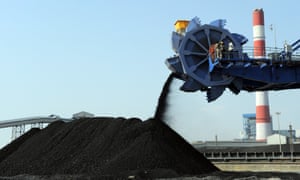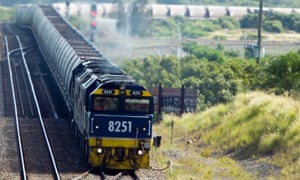Its potential environmental impact on vulnerable species has caused outrage, yet it is the fight to make the mine viable that may yet pose the greatest challenge

The sudden importance of two humble reptiles in the context of what would be Australia’s largest coal mine represents yet another stumbling block for Indian corporate giant Adani.
But on their own, the snake and the skink are unlikely to sink the Carmichael mine.
Yes, the federal court ruling – that the environment minister, Greg Hunt, failed to consider all departmental advice on protecting the two vulnerable species when approving the project – sends both the company and the commonwealth back to the drawing board.
Yes, the alleged bureaucratic paperwork bungle, which deprived Hunt of evidence he had seen all relevant documents, will add another two months minimum to an approval the company previously assumed it had in the bag.
Yes, it feeds into the Adani narrative that it is delays in government approvals that are forcing the company to make moves that some in the industry interpret as putting the project well and truly on ice, if not in permanent deep freeze.
Little things like axing their entire project management team, sending staff from potential equity partner Posco back to Korea and a small army of contract engineers off to find work elsewhere as the coalmining downturn bites.
The only ones left at Adani’s Eagle Street office in Brisbane, apart from in-house engineers who are reportedly on notice, appear to be the lawyers, lobbyists and senior managers and executives from India who once had enough confidence in the company’s long-term outlook in Australia to plunge into the local property market.
A perusal of local property records shows none of those are selling up – not yet, at least.
And there is no reason at this stage to think the commonwealth will not arrive at a defensible mitigation strategy for the impact on the yakka skink and the ornamental snake and reissue approval under the Environmental Protection and Biodiversity Conservation Act.
Or that the Queensland government will not go ahead and grant a mining lease and environmental authority to Adani, even if a looming state land court ruling on a separate challenge by conservationists recommends against it.
‘The clock is ticking’
But in the end the future of Carmichael is far more likely to hinge on its own problematic business case than whether it ticks all the boxes for governments who in public remain broadly supportive (whatever doubts they may have expressed privately).
Advertisement
In short, on a read of Adani’s own modelling, the tipping point for the Carmichael project lies somewhere between US$80-100 for the price of thermal coal, in the form of the Newcastle benchmark. It currently sits at US$60.
Set aside for a moment the argument made by critics that Adani’s Carmichael coal would be worth 30% less than the Newcastle benchmark because of its higher ash content and its lower energy count. The best guess over the next five years, according to the futures market, is that by 2020 the Newcastle benchmark will sit at US$58.
This hints at what some analysts have referred to as a “structural decline in the global seaborne thermal coal market”.
According to Michael Roche, the Queensland Resources Council’s chief executive: “The clock is ticking on this project.”
But the rebound that makes the project viable, on paper at least, could be a long time coming. It is not as if Adani has spent too much on Carmichael already that it can’t walk away. The figure often cited is something just shy of $4bn.
But of Adani’s Australian spending, more than $2bn went to the purchase of the existing T1 port at Abbot Point. The port is already given over to other coal exporters such as Glencore, Rio and BHP and will be accepting nothing from Adani’s own Carmichael mine, hence the need to build the new T0 terminal. The purchase was so highly geared, at 90% debt funding, that it cannot be used as collateral to leverage more money for the Carmichael project. It is in effect a separate play for Adani altogether.
 Facebook Twitter Pinterest
Facebook Twitter Pinterest That leaves $1.3bn that Adani has spent directly on its own mining export project, including land, engineering plans (now suspended) and so on. In any case, Rio sank $4bn itself before walking away from a project in Mozambique.
While the ultimate price tag for the mine, rail and new terminal will be $14bn, Adani says it needs to stump up just $4bn to get the project off the ground.
It indicates this is possible because it has broken the project into two stages. The first is an operation producing 32m-34m tonnes of coal a year with a 30-year mine life, the second – which will attract the additional investment once the cash is flowing – a 40m tonnes-a-year operation that lasts 60 years.
But there are questions about whether Adani can actually build the associated infrastructure in the rail and the port to a smaller scale in the first instance.
Can a rail line – which according to longstanding projections needs to be a 60m-tonnes-a-year operation to be viable – or a jetty be half built? Will $4bn really cut it?
And where is the money coming from? The only investor in Adani mining in Australia to date is its Indian parent, Adani Enterprises.
The company has indicated Adani Enterprises would fund the mine up to $4.5bn but the private Adani family companies would fund the rail line and port costing up to another $4bn each.
Adani Enterprises announced last week it would seek shareholder approval to raise US$2.7bn through debt and equity raising.
Advertisement
A major restructure of Adani Enterprises in June, by hiving off operations including the valuable Indian port assets into other companies, turned an entity worth US$10bn into one worth US$1.5bn.
Which makes borrowing tougher. And a bank is yet to explicitly bankroll Carmichael. The prospects appear even dimmer in light of the Commonwealth bank ending its advisory role over financing the Carmichael project.
It also raises the prospect Adani will get a grilling from the equity market on why it should sink nearly US$1bn into a greenfield coalmine that doesn’t appear viable on the coal price for the next five years.
Which still leaves the Adani family companies covering the rest. One option is a margin loan, using the genuine value of Indian ports in particular as collateral. But margin loans are difficult to get in India – not to mention a dangerous move that would invite share price attacks on Adani interests once hedge fund raiders smell blood.
The funding of Carmichael is a labyrinth that could make Adani’s path to Australian government approvals seem like a walk in the park.

